
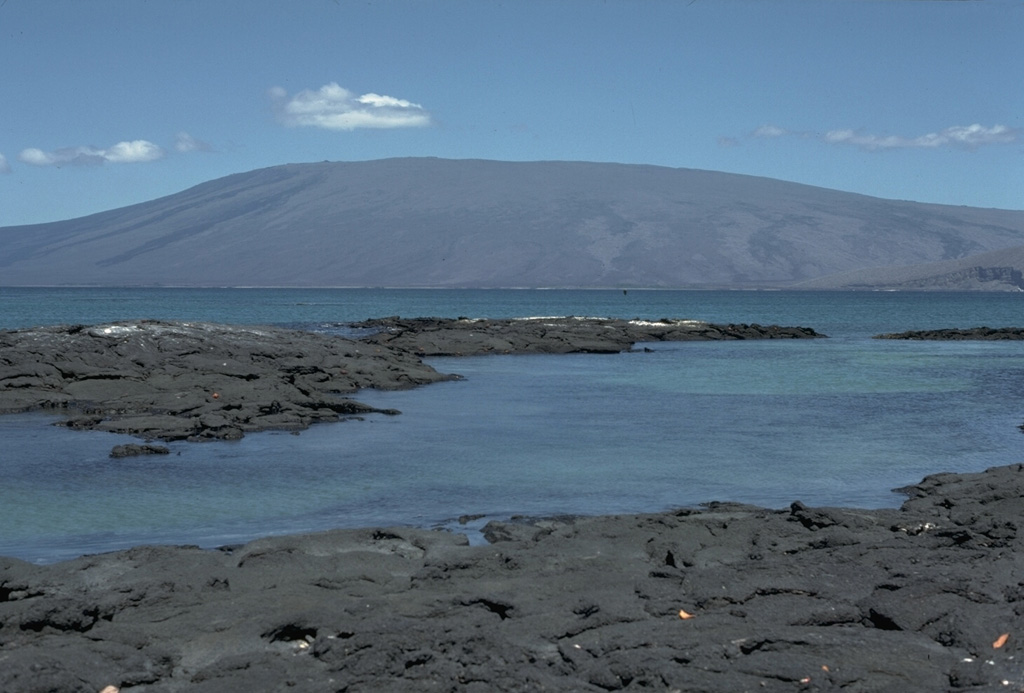
Thermal anomalies, but no confirmed activity
Card 1752 (13 December 1973) Hot-spots on E flank detected on infrared satellite imagery
Observations from space... support previous indication of eruption on Wolf (Event Card 1749), and suggest strong thermal activity on Darwin. . . .
Card 1757 (17 December 1973) Infrared hot-spot probably not eruption related
Close inspection of NOAA-2 imagery shows hot spots reported on Event Card 1752 coincide with caldera floors, not outer flanks, and can probably be explained by normal daytime temperature differences. . . .
Information Contacts:
Card 1752 (13 December 1973) F. Parmenter, NOAA; M. McEwen, NASA; J. Filson, MIT; T. Simkin, SI.
Card 1757 (17 December 1973) A. Krueger and F. Parmenter, NOAA; J. Filson, MIT; P. Kramer, Darwin Research Station; T. Simkin, SI.
The Global Volcanism Program has no Weekly Reports available for Darwin.
Reports are organized chronologically and indexed below by Month/Year (Publication Volume:Number), and include a one-line summary. Click on the index link or scroll down to read the reports.
Aerial reconnaissance shows caldera unchanged
Card 1249 (07 July 1971)
". . . recent inspection of volcano Fernandina . . . shows that the caldera has not resumed the collapse begun in 1968. The caldera remains essentially the same and aerial reconnaissance of nearby calderas, Wolf and Darwin (Isla Isabella) are likewise unchanged. . . ."
Information Contacts: Educational Expeditions International Research Team, Galapagos Islands, Ecuador; T. Simkin, SI.
Thermal anomalies, but no confirmed activity
Card 1752 (13 December 1973) Hot-spots on E flank detected on infrared satellite imagery
Observations from space... support previous indication of eruption on Wolf (Event Card 1749), and suggest strong thermal activity on Darwin. . . .
Card 1757 (17 December 1973) Infrared hot-spot probably not eruption related
Close inspection of NOAA-2 imagery shows hot spots reported on Event Card 1752 coincide with caldera floors, not outer flanks, and can probably be explained by normal daytime temperature differences. . . .
Information Contacts:
Card 1752 (13 December 1973) F. Parmenter, NOAA; M. McEwen, NASA; J. Filson, MIT; T. Simkin, SI.
Card 1757 (17 December 1973) A. Krueger and F. Parmenter, NOAA; J. Filson, MIT; P. Kramer, Darwin Research Station; T. Simkin, SI.
This compilation of synonyms and subsidiary features may not be comprehensive. Features are organized into four major categories: Cones, Craters, Domes, and Thermal Features. Synonyms of features appear indented below the primary name. In some cases additional feature type, elevation, or location details are provided.
Synonyms |
||||
| Williams, Mount | ||||
Cones |
||||
| Feature Name | Feature Type | Elevation | Latitude | Longitude |
| Beagle | Tuff cone | |||
| Tagus | Tuff cone | |||
|
|
||||||||||||||||||||||||||||
There is data available for 3 confirmed Holocene eruptive periods.
1813 Jun 6 - 1813 Jun 7 (?) Confirmed Eruption VEI: 2 (?)
| Episode 1 | Eruption | Volcano Uncertain: more likely Darwin than Wolf, Alcedo | |||||||||||||||||||
|---|---|---|---|---|---|---|---|---|---|---|---|---|---|---|---|---|---|---|---|---|
| 1813 Jun 6 - 1813 Jun 7 (?) | Evidence from Observations: Reported | |||||||||||||||||||
|
List of 2 Events for Episode 1 at Volcano Uncertain: more likely Darwin than Wolf, Alcedo
| ||||||||||||||||||||
1150 ± 300 years Confirmed Eruption VEI: 0
| Episode 1 | Eruption | ||||||||||||||||||||
|---|---|---|---|---|---|---|---|---|---|---|---|---|---|---|---|---|---|---|---|---|
| 1150 ± 300 years - Unknown | Evidence from Isotopic: Cosmic Ray Exposure | |||||||||||||||||||
|
List of 2 Events for Episode 1
| ||||||||||||||||||||
0210 ± 500 years Confirmed Eruption VEI: 0
| Episode 1 | Eruption | ||||||||||||||||||||
|---|---|---|---|---|---|---|---|---|---|---|---|---|---|---|---|---|---|---|---|---|
| 0210 ± 500 years - Unknown | Evidence from Isotopic: Cosmic Ray Exposure | |||||||||||||||||||
|
List of 2 Events for Episode 1
| ||||||||||||||||||||
There is data available for 1 deformation periods. Expand each entry for additional details.
Reference List: Amelung et al. 2000.
Full References:
Amelung F, Jónsson S, Zebker H, Segall P, 2000. Widespread uplift and "trap-door" faulting on Galápagos volcanoes observed with radar interferometry. Nature, 407, 993-996. https://doi.org/10.1038/35039604
There is no Emissions History data available for Darwin.
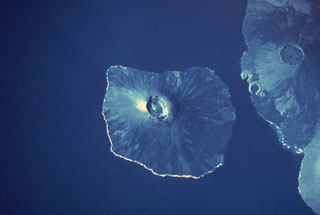 Two massive Galápagos shield volcanoes, their slopes darkened by young unvegetated lava flows that reach to the sea, appear in this space-shuttle photograph. Fernandina volcano, the most active in the Galápagos Islands, forms a 30 x 34 km wide island with a 4 x 6.5 km wide caldera at its summit. Darwin volcano, north of the midpoint of Isabela Island, has a 5-km-wide summit caldera. The tuff cones of Tagus and Beagle are prominent along its western coast. The light-colored area south of Darwin is the lower western flank of Alcedo volcano.
Two massive Galápagos shield volcanoes, their slopes darkened by young unvegetated lava flows that reach to the sea, appear in this space-shuttle photograph. Fernandina volcano, the most active in the Galápagos Islands, forms a 30 x 34 km wide island with a 4 x 6.5 km wide caldera at its summit. Darwin volcano, north of the midpoint of Isabela Island, has a 5-km-wide summit caldera. The tuff cones of Tagus and Beagle are prominent along its western coast. The light-colored area south of Darwin is the lower western flank of Alcedo volcano. Volcán Darwin, named after the Charles Darwin, seen above a narrow channel opposite Point Espinosa on the NE tip of Fernandina Island. Darwin volcano has 5-km-wide summit caldera that is largely filled by lava flows. The most recent summit activity produced several small lava flows from vents on the eastern caldera floor, and NE and SE caldera rims. Two breached tuff cones on the SW-flank coast, Tagus and Beagle, were a prominent part of Darwin's geological studies in the Galápagos Islands.
Volcán Darwin, named after the Charles Darwin, seen above a narrow channel opposite Point Espinosa on the NE tip of Fernandina Island. Darwin volcano has 5-km-wide summit caldera that is largely filled by lava flows. The most recent summit activity produced several small lava flows from vents on the eastern caldera floor, and NE and SE caldera rims. Two breached tuff cones on the SW-flank coast, Tagus and Beagle, were a prominent part of Darwin's geological studies in the Galápagos Islands. The tuff cones of Tagus (upper left) and Beagle (lower right) were formed by phreatomagmatic eruptions at Darwin volcano in the Galápagos Islands. The rim of Tagus is breached by Tagus Cove that was visited by Charles Darwin's vessel, the Beagle. Tagus tuff cone has at least four nested craters, the youngest of which contains a small salt lake. Young black lava flows from fissures on the flanks largely surround the tuff cones.
The tuff cones of Tagus (upper left) and Beagle (lower right) were formed by phreatomagmatic eruptions at Darwin volcano in the Galápagos Islands. The rim of Tagus is breached by Tagus Cove that was visited by Charles Darwin's vessel, the Beagle. Tagus tuff cone has at least four nested craters, the youngest of which contains a small salt lake. Young black lava flows from fissures on the flanks largely surround the tuff cones.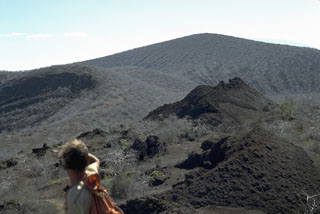 The spatter cones at the right are part of a chain of conelets built of scoria and lava agglutinate erupted from a SW-flank radial fissure from Darwin volcano that cuts across the rim of Tagus tuff cone. Tagus tuff cone contains at least four nested craters. The rims of three of these craters are seen in the backgound. Phreatomagmatic eruptions, resulting from the interaction of magma with seawater, produced the tuff cones.
The spatter cones at the right are part of a chain of conelets built of scoria and lava agglutinate erupted from a SW-flank radial fissure from Darwin volcano that cuts across the rim of Tagus tuff cone. Tagus tuff cone contains at least four nested craters. The rims of three of these craters are seen in the backgound. Phreatomagmatic eruptions, resulting from the interaction of magma with seawater, produced the tuff cones.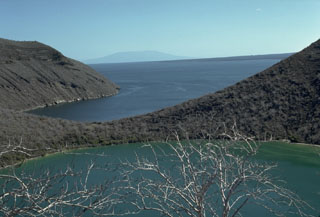 The smallest of at least four nested craters on Tagus tuff cone, located on the SW flank of Darwin volcano, is filled by a small lake. The ridge at the upper left is the SE rim of the tuff cone, which is breached by Tagus Cove, one of the most renowned anchorages in the Galápagos archipelago. Cerro Azul shield volcano rises in the distance at the southern end of Isabela Island.
The smallest of at least four nested craters on Tagus tuff cone, located on the SW flank of Darwin volcano, is filled by a small lake. The ridge at the upper left is the SE rim of the tuff cone, which is breached by Tagus Cove, one of the most renowned anchorages in the Galápagos archipelago. Cerro Azul shield volcano rises in the distance at the southern end of Isabela Island. 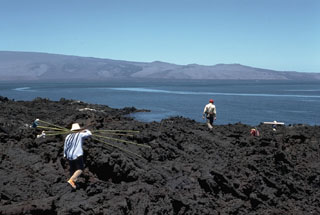 The smooth flank of Darwin shield volcano, seen here from the east coast of Fernandina Island, is modified by a cluster of tuff cones near the SW base of the volcano. The Tagus and Beagle tuff cones (right center horizon) were formed by phreatomagmatic eruptions along the SW coast of Darwin. Fresh black lava flows erupted from fissures on the flanks of Darwin volcano descend to the sea on both sides of the tuff-cone complex.
The smooth flank of Darwin shield volcano, seen here from the east coast of Fernandina Island, is modified by a cluster of tuff cones near the SW base of the volcano. The Tagus and Beagle tuff cones (right center horizon) were formed by phreatomagmatic eruptions along the SW coast of Darwin. Fresh black lava flows erupted from fissures on the flanks of Darwin volcano descend to the sea on both sides of the tuff-cone complex. 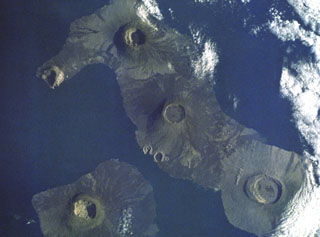 This dramatic Space Shuttle photo from a 1988 mission shows five major calderas of the Galápagos Islands. Caldera diameters capping these basasltic shield volcanoes range up to 8 km. At the lower left is Fernandina volcano. At the lower right is mostly vegetated Alcedo volcano on Isabela Island. Above and to the left is Darwin volcano, with the two prominent breached tuff cones, Tagus and Beagle, on its SW flank. Volcán Wolf is at the top of the photo, and Volcán Ecuador with its breached caldera forms the NW tip of Isabela Island.
This dramatic Space Shuttle photo from a 1988 mission shows five major calderas of the Galápagos Islands. Caldera diameters capping these basasltic shield volcanoes range up to 8 km. At the lower left is Fernandina volcano. At the lower right is mostly vegetated Alcedo volcano on Isabela Island. Above and to the left is Darwin volcano, with the two prominent breached tuff cones, Tagus and Beagle, on its SW flank. Volcán Wolf is at the top of the photo, and Volcán Ecuador with its breached caldera forms the NW tip of Isabela Island.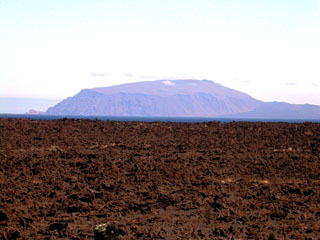 Volcán Ecuador, which straddles the equator at the NW end of Isabela Island, rises beyond a lava flow near Beagle tuff cone on the flanks of Darwin volcano. Ecuador is the smallest of the six large shield volcanoes on Isabela and is broadly breached to the coast on the side opposite this view. No historical eruptions are known; however, the youthful morphology of its most recent lava flows resembles those of very recent flows on other Isabela Island volcanoes. A line of NE-trending fissure-fed vents (right horizon) extends to the SE.
Volcán Ecuador, which straddles the equator at the NW end of Isabela Island, rises beyond a lava flow near Beagle tuff cone on the flanks of Darwin volcano. Ecuador is the smallest of the six large shield volcanoes on Isabela and is broadly breached to the coast on the side opposite this view. No historical eruptions are known; however, the youthful morphology of its most recent lava flows resembles those of very recent flows on other Isabela Island volcanoes. A line of NE-trending fissure-fed vents (right horizon) extends to the SE. A spectacular aerial view from the SE shows the caldera of Darwin volcano in the foreground, with Volcán Wolf in the right background and the tip of Volcán Ecuador at the NW tip of Isabella Island on far left horizon. Volcán Darwin, named after the renowned naturalist, contains a symmetrical 5-km-wide, 200-m-deep summit caldera whose floor is nearly covered by youthful lava flows. A broad terrace occupies the SW part of the caldera (left side). Fresh-looking, dark-colored lava flows from flank fissures are visible between Darwin and Wolf volcanoes.
A spectacular aerial view from the SE shows the caldera of Darwin volcano in the foreground, with Volcán Wolf in the right background and the tip of Volcán Ecuador at the NW tip of Isabella Island on far left horizon. Volcán Darwin, named after the renowned naturalist, contains a symmetrical 5-km-wide, 200-m-deep summit caldera whose floor is nearly covered by youthful lava flows. A broad terrace occupies the SW part of the caldera (left side). Fresh-looking, dark-colored lava flows from flank fissures are visible between Darwin and Wolf volcanoes.  The 5-km-diameter, 200-m-deep summit caldera of the Volcán Darwin is near the center of this March 2019 Planet Labs satellite image monthly mosaic (N is at the top). Lava flows on all flanks have erupted from circumferential and radial fissures around the flanks and into the caldera. The Beagle and Tagus tuff cones are along the SW coastline, with the northern Tagus Cone containing Tagus Cove. Fernandina is SW and the northern flanks of Alcedo are S; Volcán Darwin is out of view to the N.
The 5-km-diameter, 200-m-deep summit caldera of the Volcán Darwin is near the center of this March 2019 Planet Labs satellite image monthly mosaic (N is at the top). Lava flows on all flanks have erupted from circumferential and radial fissures around the flanks and into the caldera. The Beagle and Tagus tuff cones are along the SW coastline, with the northern Tagus Cone containing Tagus Cove. Fernandina is SW and the northern flanks of Alcedo are S; Volcán Darwin is out of view to the N.Maps are not currently available due to technical issues.
There are no samples for Darwin in the Smithsonian's NMNH Department of Mineral Sciences Rock and Ore collection.
| Copernicus Browser | The Copernicus Browser replaced the Sentinel Hub Playground browser in 2023, to provide access to Earth observation archives from the Copernicus Data Space Ecosystem, the main distribution platform for data from the EU Copernicus missions. |
| MIROVA | Middle InfraRed Observation of Volcanic Activity (MIROVA) is a near real time volcanic hot-spot detection system based on the analysis of MODIS (Moderate Resolution Imaging Spectroradiometer) data. In particular, MIROVA uses the Middle InfraRed Radiation (MIR), measured over target volcanoes, in order to detect, locate and measure the heat radiation sourced from volcanic activity. |
| MODVOLC Thermal Alerts | Using infrared satellite Moderate Resolution Imaging Spectroradiometer (MODIS) data, scientists at the Hawai'i Institute of Geophysics and Planetology, University of Hawai'i, developed an automated system called MODVOLC to map thermal hot-spots in near real time. For each MODIS image, the algorithm automatically scans each 1 km pixel within it to check for high-temperature hot-spots. When one is found the date, time, location, and intensity are recorded. MODIS looks at every square km of the Earth every 48 hours, once during the day and once during the night, and the presence of two MODIS sensors in space allows at least four hot-spot observations every two days. Each day updated global maps are compiled to display the locations of all hot spots detected in the previous 24 hours. There is a drop-down list with volcano names which allow users to 'zoom-in' and examine the distribution of hot-spots at a variety of spatial scales. |
|
WOVOdat
Single Volcano View Temporal Evolution of Unrest Side by Side Volcanoes |
WOVOdat is a database of volcanic unrest; instrumentally and visually recorded changes in seismicity, ground deformation, gas emission, and other parameters from their normal baselines. It is sponsored by the World Organization of Volcano Observatories (WOVO) and presently hosted at the Earth Observatory of Singapore.
GVMID Data on Volcano Monitoring Infrastructure The Global Volcano Monitoring Infrastructure Database GVMID, is aimed at documenting and improving capabilities of volcano monitoring from the ground and space. GVMID should provide a snapshot and baseline view of the techniques and instrumentation that are in place at various volcanoes, which can be use by volcano observatories as reference to setup new monitoring system or improving networks at a specific volcano. These data will allow identification of what monitoring gaps exist, which can be then targeted by remote sensing infrastructure and future instrument deployments. |
| Volcanic Hazard Maps | The IAVCEI Commission on Volcanic Hazards and Risk has a Volcanic Hazard Maps database designed to serve as a resource for hazard mappers (or other interested parties) to explore how common issues in hazard map development have been addressed at different volcanoes, in different countries, for different hazards, and for different intended audiences. In addition to the comprehensive, searchable Volcanic Hazard Maps Database, this website contains information about diversity of volcanic hazard maps, illustrated using examples from the database. This site is for educational purposes related to volcanic hazard maps. Hazard maps found on this website should not be used for emergency purposes. For the most recent, official hazard map for a particular volcano, please seek out the proper institutional authorities on the matter. |
| IRIS seismic stations/networks | Incorporated Research Institutions for Seismology (IRIS) Data Services map showing the location of seismic stations from all available networks (permanent or temporary) within a radius of 0.18° (about 20 km at mid-latitudes) from the given location of Darwin. Users can customize a variety of filters and options in the left panel. Note that if there are no stations are known the map will default to show the entire world with a "No data matched request" error notice. |
| UNAVCO GPS/GNSS stations | Geodetic Data Services map from UNAVCO showing the location of GPS/GNSS stations from all available networks (permanent or temporary) within a radius of 20 km from the given location of Darwin. Users can customize the data search based on station or network names, location, and time window. Requires Adobe Flash Player. |
| DECADE Data | The DECADE portal, still in the developmental stage, serves as an example of the proposed interoperability between The Smithsonian Institution's Global Volcanism Program, the Mapping Gas Emissions (MaGa) Database, and the EarthChem Geochemical Portal. The Deep Earth Carbon Degassing (DECADE) initiative seeks to use new and established technologies to determine accurate global fluxes of volcanic CO2 to the atmosphere, but installing CO2 monitoring networks on 20 of the world's 150 most actively degassing volcanoes. The group uses related laboratory-based studies (direct gas sampling and analysis, melt inclusions) to provide new data for direct degassing of deep earth carbon to the atmosphere. |
| Large Eruptions of Darwin | Information about large Quaternary eruptions (VEI >= 4) is cataloged in the Large Magnitude Explosive Volcanic Eruptions (LaMEVE) database of the Volcano Global Risk Identification and Analysis Project (VOGRIPA). |
| EarthChem | EarthChem develops and maintains databases, software, and services that support the preservation, discovery, access and analysis of geochemical data, and facilitate their integration with the broad array of other available earth science parameters. EarthChem is operated by a joint team of disciplinary scientists, data scientists, data managers and information technology developers who are part of the NSF-funded data facility Integrated Earth Data Applications (IEDA). IEDA is a collaborative effort of EarthChem and the Marine Geoscience Data System (MGDS). |